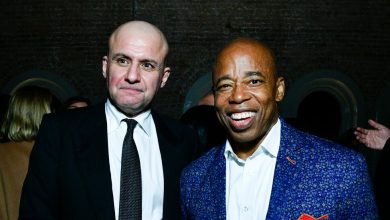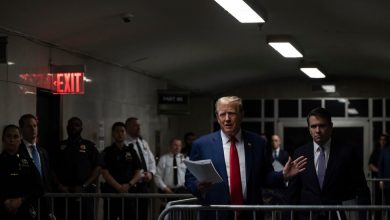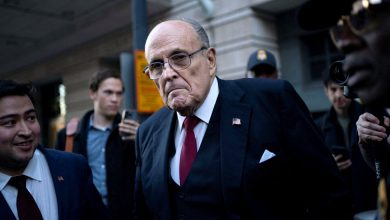As Protests Grow, Universities Choose Different Ways to End Unrest

The first time Columbia University tried to shut down the pro-Palestinian encampment on its campus, two weeks ago, it called in the New York Police Department. That backfired. Students who were not arrested reestablished a larger encampment on the next lawn over and drew hundreds of protesters from across the city and beyond who rallied at the campus’s gates.
The second time the university attempted to shut down the encampment, on Monday, it tried something different. It offered students who left by a deadline partial amnesty from punishment; if they refused, Columbia would suspend them. That tactic also failed to end the unrest. Instead, a subgroup of protesters took over a campus building, Hamilton Hall, in the middle of the night.
Finally, on Tuesday evening, the university brought in the police again, to rout protesters from the building and encampment. More than 100 people were arrested. As some demonstrators continued to rally outside the gates, and faculty members and students reeled over what had just happened, a question loomed: Would this be the end of weeks of escalating protests on Columbia’s campus?
Across the nation, different schools are facing the same question, with no easy answers. Some administrators have called in the police. Others have met with students at the negotiating table. In all cases, university officials are no doubt watching the school calendar, counting the days until the semester ends, but also until a flood of families comes to campus for graduation ceremonies.
The difficulty administrators face stems in large part from one of the demands that student protesters are making: that schools end financial ties with companies supporting Israel. Students at Columbia and elsewhere also want universities to publicly disclose all of their investments, to ensure accountability for divestment.
For universities, considering those demands raises a host of problems, both logistical and political, that may make acquiescing nearly impossible.
The protesters point to victories by previous campus movements that won similar demands, including the 1968 takeover of Hamilton Hall and other campus buildings, which ultimately led the school to disaffiliate from a weapons research institute involved in the Vietnam War and end its plans to build a gym in a Harlem park. In 1985, Columbia became the first Ivy League university to divest from South Africa after student protests.
“I think we can see throughout history, especially on Columbia’s campus, when escalations like these have happened, there has been success,” said Cameron Jones, an undergraduate protester with Columbia’s Jewish Voice for Peace, a pro-Palestinian group that was suspended last year for not following protest rules. “You can look at the fight for divestment from apartheid South Africa, fossil fuel divestment, private prison divestment, escalations do work. So that’s why we as students are doing it.”
Even as Columbia turned to the police again to tamp down on protests this week, another Ivy League school seemed to find a way to bring the protests to an end by saying it would consider student demands.
On Tuesday, Brown University announced that it had reached an agreement with protesters to peacefully end an encampment there. According to the agreement, which has been signed by students who represent the Brown Divest Coalition, students say they will remove their tents, among other things.
In exchange, Brown agreed that five students would be invited to meet with members of the Corporation of Brown University to discuss divestment. The corporation will hold a vote on the matter at its October 2024 meeting, Christina H. Paxson, Brown’s president, wrote in a letter to the community.
The student movement saw it as a victory that the issue even got to the table. Still, that does not mean the university will ultimately decide to divest.
“We do hope a vote by the Brown Corporation in October, either for or against divestment, will bring clarity to an issue that is of longstanding interest to many members of our community,” said Brian Clark, a university spokesman, in a statement.
Columbia, for its part, has faced enormous internal and external pressures, making any official move toward divestment in Israel highly unlikely, even though its undergraduates voted to support divestment in an April referendum.
Nemat Shafik, Columbia’s president, appeared in Congress two weeks ago and largely agreed with the Republican-led committee that the pro-Palestinian protests on her campus included antisemitic rhetoric and were making the campus feel unsafe for many Jewish students. Any steps that the university takes to distance itself from Israel would bring additional criticism and amplify the pressure Dr. Shafik faces to clamp down.
In a statement Monday, Ms. Shafik said Columbia would not divest from Israel, but that it had offered protesters “an expedited timeline for review” of new proposals to go before the Advisory Committee on Socially Responsible Investing, the university group focused on ethical investing.
Columbia is facing at least three lawsuits from Jewish students arguing that the school has allowed a discriminatory environment for Jewish students to emerge on campus. The school is also facing congressional and federal civil rights investigations, and pressure from donors, alumni groups and parents. There are hundreds of Israeli students on campus, and thousands of Jewish students, though only some say they feel threatened.
In addition, most states, including New York, also have laws that bar public institutions from divesting from Israel, or ban them from entering into contracts with companies that call for boycotts of Israel, to guard against the Boycott, Divestment and Sanctions movement that targets Israel. Opponents see the movement as antisemitic for singling out the world’s only Jewish-majority state.
There are also technical reasons that divestment would be more difficult now than it was following protests in decades past.
In the 1980s, weeks of sit-ins at Columbia led the school to announce that it would be selling $39 million in stock from companies like Coca-Cola, Ford Motor and Mobil Oil because of their investments in South Africa.
But compared to universities in the ’80s, those today invest less of their endowments in individual stocks, with more tied up in general index funds and private equity, which are handled by managers independent of the schools. Private universities report some of their holdings in public portfolios, but that’s a tiny sliver of the pie.
“For places like Columbia and N.Y.U. that heavily invest in hedge funds, it becomes pretty hard to even know if you’re spending money in Israel,” said Chris Marsicano, a professor of educational studies and public policy at Davidson College.
In a written proposal submitted last December, activists at Columbia listed a number of companies they wanted the school to divest from, including Google, which has a large contract with the Israeli military, and Airbnb, which advertises listings on Israeli settlements in the West Bank. It also named the university’s indirect holdings in companies like Caterpillar, a maker of armored bulldozers for the Israeli government, which Columbia owns in an exchange-trade fund managed by BlackRock, the world’s largest asset manager.
The school’s socially responsible investing advisers have created a list of companies in tobacco, private prisons and fossil fuels that the university does not directly invest in. But that committee rejected student organizers’ divestment proposal back in March.
On Monday, as Brown protesters were packing up their tents after agreeing to continue talks about divestment next fall, Columbia shut down negotiations with the student coalition that had led the encampment, saying the talks had come to an impasse. On Tuesday, it called in the police to remove protesters.
By Wednesday, the atmosphere was quiet on both campuses.
At Brown, the encampment was gone. The area where tents once stood was surrounded by new metal fencing.
Outside of Columbia’s gates, a small group of students and faculty members picketed under the watchful eye of the police, holding up signs saying “Divest Now” and “No Cops on Campus.” Inside the largely locked down campus, protesters were absent and the remnants of the encampments had been removed.
Jenna Russell contributed reporting.




